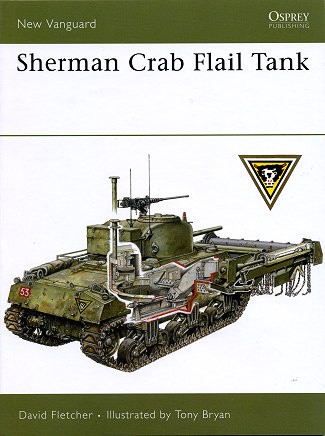 To me,
the New Vanguard Series is one of the best that Osprey does. These books get a
chance to concentrate on one subject and look into it with some depth. They are
also usually of a subject that one generally does not think of in the normal
conversation of the period. Such it is with this one on the Sherman 'Crab'.
To me,
the New Vanguard Series is one of the best that Osprey does. These books get a
chance to concentrate on one subject and look into it with some depth. They are
also usually of a subject that one generally does not think of in the normal
conversation of the period. Such it is with this one on the Sherman 'Crab'.
The flail tank is a piece of equipment that was pretty well a
WWII development and one that did not last long after the war. It was recognized
by the British, who were fighting Rommel in North Africa at the time, that there
needed to be a relatively quick way to get through the numerous mine fields that
the Germans had set up. Mine warfare in the desert was just about the only way
to set up a workable defensive barricade as there was little else available.
These mine fields were a way of channeling invading forces into a tight area
where the defensive guns would be able to cut them down with withering fire.
As most mines will simply blow a hole in the ground if there
is not something above it to provide compression and increase the blast damage,
it was thought that some sort of contraption out ahead of the tank would work to
explode these mines and not damage the tank itself. Thus the idea of a flail,
basically a moving cylinder with chains attached to beat the ground and explode
mines.
This works quite well, but the real problem was designing one
that wasn't a mass of gears and pulleys. Another problem was that these flails
were large and heavy, requiring considerable power to move. The experiments
provided some rather bulky and clumsy contraptions. In North Africa, the
Scorpion, a flail tank developed on the Matilda was built in the field and while
it worked, it was not very successful in that there were constant mechanical
breakdowns with few of the tanks surviving the campaign.
While this work was going on in North Africa, there was
concurrent design work going on in the UK. Through much trial and error, the
Sherman was chosen for the base tank and eventually the Sherman 'Crab' flail
tank was developed in time to be used in the Normandy invasion and other
campaigns until war's end.
The author does a sterling job of telling this somewhat
convoluted, but immensely interesting story of the development of this weapon.
All of it is ably illustrated by Tony Bryan and there are the usual quality
period photographs to accompany the story.
It makes for another superb edition on a most interesting
piece of equipment and a tale you are sure to enjoy.
October 2007
For more on the complete line of Osprey books,
visit www.ospreypublishing.com. In the US, it is
Osprey Direct at 44-02 23rd St, Suite 219, Long Island City, NY 11101., where you can
get a catalogue of available books.
If you would like your product reviewed fairly and quickly, please contact
me or see other details in the Note to
Contributors.
 To me,
the New Vanguard Series is one of the best that Osprey does. These books get a
chance to concentrate on one subject and look into it with some depth. They are
also usually of a subject that one generally does not think of in the normal
conversation of the period. Such it is with this one on the Sherman 'Crab'.
To me,
the New Vanguard Series is one of the best that Osprey does. These books get a
chance to concentrate on one subject and look into it with some depth. They are
also usually of a subject that one generally does not think of in the normal
conversation of the period. Such it is with this one on the Sherman 'Crab'.